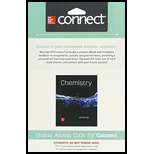
A 5.00-mol sample of
Interpretation:
The percent error in pressure value from the ideal gas equation as compared to the van der Waal’s equation for
Concept introduction:
The ideal gas equation elaborates the physical properties of gases by relating the pressure, volume, temperature and number of moles linked with each other with the help of gas laws.
This can be shown by:
Here, R represents the universal gas constant,
The percentage error is equal to the percent of difference between exact and experimental values, that is, if this difference is divided by the exact value and multiplied by 100 to make percent, then the percent error is obtained.
The deviation of real gas from the ideal gas can be calculated with the help of van der walls equation as follows:
Here, a and b represent the van der wall constants, which have different values for different gases, R represents the gas constant,
Answer to Problem 149AP
Solution:
Explanation of Solution
Given information:
Number of moles
Volume
Temperature
The equation for an ideal gas is as follows:
Substitute
The value of van der walls constant
The value of van der walls constant
Now, the corrected value in both pressure and volume can be calculated as follows:
For pressure,
For volume,
The van der walls equation for a gas is as follows:
Substitute
The value of pressure can be solved as
The error in pressure value from the ideal gas equation can be calculated as
Substitute
Hence, the percent error in pressure value from the ideal gas equation is
Want to see more full solutions like this?
Chapter 10 Solutions
Connect 2-Year Access Card for Chemistry
- In the text, it is stated that the pressure of 4.00 mol of Cl2 in a 4.00-L tank at 100.0 C should be 26.0 atm if calculated using the van der Waals equation. Verify this result, and compare it with the pressure predicted by the ideal gas law.arrow_forwardCalculate the pressure, in atm, of 10.2 mol argon at 530 C in a 3.23-L container, using both the ideal gas law and the van der Waals equation.arrow_forwardA mixture at 33 °C contains H2at 325 torr. N;at 475 tore and O2at 650. torr. What is the total pressure of the gases in the system? Which gas contains the greatest number of moles?arrow_forward
- A collapsed balloon is filled with He to a volume of 12.5 L at a pressure of 1.00 atm. Oxygen, O2, is then added so that the final volume of the balloon is 26 L with a total pressure of 1.00 atm. The temperature, which remains constant throughout, is 21.5 C. (a) What mass of He does the balloon contain? (b) What is the final partial pressure of He in the balloon? (c) What is the partial pressure of O2 in the balloon? (d) What is the mole fraction of each gas?arrow_forwardHydrogen gas is used in weather balloon because it is less expensive than Helium. Assume that 5.57 g of H2 is used to fill a weather balloon to an initial volume of 67 L at 1.04 atm. If the ballloon rises to an altitude where the pressure is 0.047 atm, what is its new volume? Assume that the temperature remains constant.arrow_forward
 Chemistry: An Atoms First ApproachChemistryISBN:9781305079243Author:Steven S. Zumdahl, Susan A. ZumdahlPublisher:Cengage Learning
Chemistry: An Atoms First ApproachChemistryISBN:9781305079243Author:Steven S. Zumdahl, Susan A. ZumdahlPublisher:Cengage Learning ChemistryChemistryISBN:9781305957404Author:Steven S. Zumdahl, Susan A. Zumdahl, Donald J. DeCostePublisher:Cengage Learning
ChemistryChemistryISBN:9781305957404Author:Steven S. Zumdahl, Susan A. Zumdahl, Donald J. DeCostePublisher:Cengage Learning
 Chemistry: Principles and PracticeChemistryISBN:9780534420123Author:Daniel L. Reger, Scott R. Goode, David W. Ball, Edward MercerPublisher:Cengage Learning
Chemistry: Principles and PracticeChemistryISBN:9780534420123Author:Daniel L. Reger, Scott R. Goode, David W. Ball, Edward MercerPublisher:Cengage Learning Introductory Chemistry: A FoundationChemistryISBN:9781285199030Author:Steven S. Zumdahl, Donald J. DeCostePublisher:Cengage Learning
Introductory Chemistry: A FoundationChemistryISBN:9781285199030Author:Steven S. Zumdahl, Donald J. DeCostePublisher:Cengage Learning Chemistry: The Molecular ScienceChemistryISBN:9781285199047Author:John W. Moore, Conrad L. StanitskiPublisher:Cengage Learning
Chemistry: The Molecular ScienceChemistryISBN:9781285199047Author:John W. Moore, Conrad L. StanitskiPublisher:Cengage Learning





